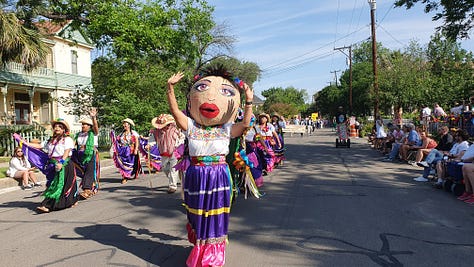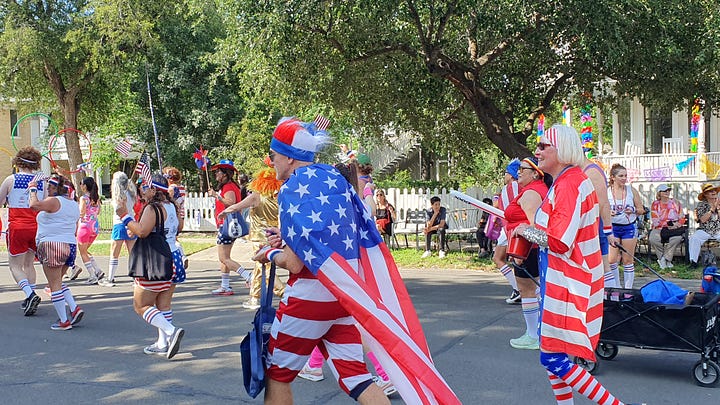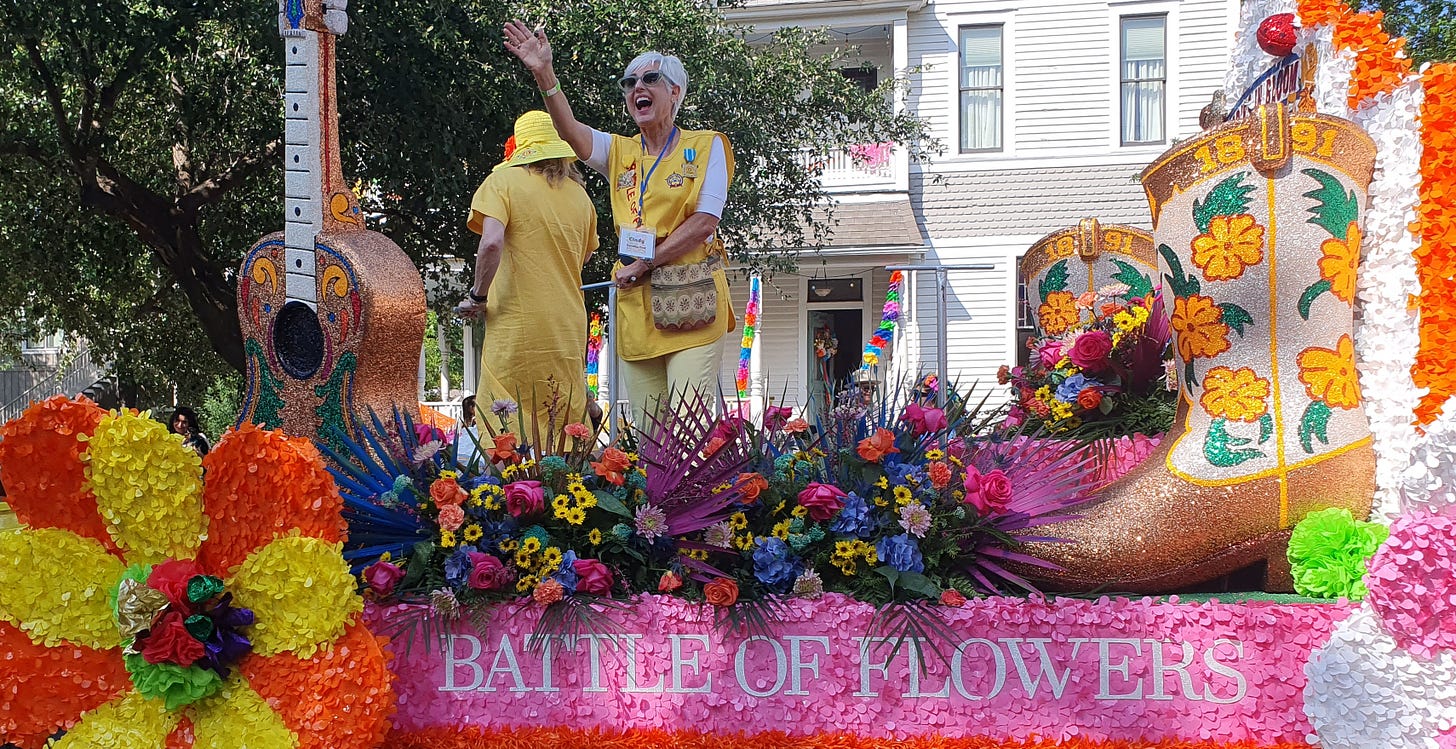It’s fiesta time again in San Antonio. For eleven days, the locals go wild, dressing up, partying and parading. And this year, I experience this hustle and bustle up close.
This time, the city's biggest festival takes place in the last few days of April and extends into May. I'm lucky with the weather: the temperatures, which usually are in the 90 degrees by this time, are pleasantly mild. Nevertheless, I stock up on sun cream as I make my way to the King William Parade on this Saturday morning. Friends tell me that it is the most creative and original event of the now very commercialized Fiesta - a colorful parade of local groups and individuals who dress up and dress down with more creativity than money, celebrating their joy of living in this city.
More than three million people, I read, are drawn to the more than 100 events that take place throughout the city and in neighboring towns every year during the eleven days of the fiesta. I meet a tourist from Seattle in the north of the USA on the border with Canada, around 2,150 miles, 32 hours by car or four hours by plane. And I myself have also come to San Antonio for the Fiesta this time. The proceeds from the parties and parades are donated to charitable projects. In total, the Fiesta is expected to raise around 340 million dollars for the community.
Many of the revelers are probably unaware of what they are actually celebrating at the festival with the Mexican name: the Fiesta commemorates the Texas War of Independence from October 1835 to April 1836, also known as the Texas Revolution. Specifically, the Battle of the Alamo, which took place in San Antonio and in which the rebellious Texans were defeated by the Mexican troops - and the Battle of San Jacinto, in which US General Sam Houston finally led the Texan army to victory in April 1836. The Fiesta is intended to honor all the Texan soldiers who fell in these two battles. According to historians, the war was at least partly triggered by the abolition of slavery by Mexico.
Fiesta San Antonio began with the first Battle of Flowers Parade on April 24, 1891, when local women decorated carriages, baby strollers and bicycles with fresh flowers and threw flowers at each other - hence the name “Battle of Flowers”. The parade is still the highlight of every Fiesta. It is also still organized exclusively by women, under the umbrella of the non-profit Battle of Flowers Association, which was founded in 1891 and officially named as such in 1909. The members are dressed in characteristic sunny yellow, including matching hats since 1973.
On their website, the women write that since then, the parade has entertained the crowds with “Spectacular flower covered floats with participants adorned in colorful costumes, giant helium balloons, horse-drawn carriages, antique cars, uniformed military, colorful cavalcades, and thousands of students in marching bands, vanguards, and pep squads”. The organizers are supported by hundreds of volunteers. A real spectacle where I was the night before. (Video ©Rebecca Hillauer)
“Show us your shoes!” This call from onlookers has become a popular tradition. Its origins can be traced back to Mardi Gras in New Orleans, says a friend. There, in the wild 1960s and 70s, women would lift their tops and expose their bare breasts when called upon. In conservative Texas, this “show” has been modified. Unlike in the Grimm Brothers' fairy tale, however, in which Cinderella is the only one who fits the dainty golden slipper, making her recognizable as the real bride: The Fiesta Queen of San Antonio and her ladies-in-waiting, gliding through the crowd on a float, coquettishly lift the hem of their glittering evening gowns at the request of the audience.. revealing unexpected, sometimes curious footwear underneath - from cowboy boots to sneakers to fluffy slippers.
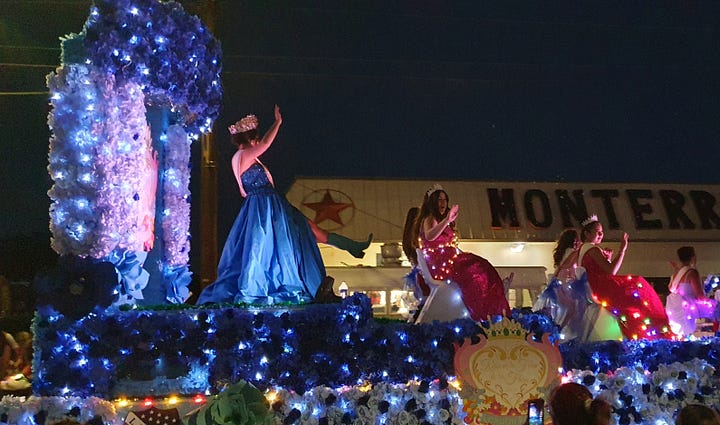
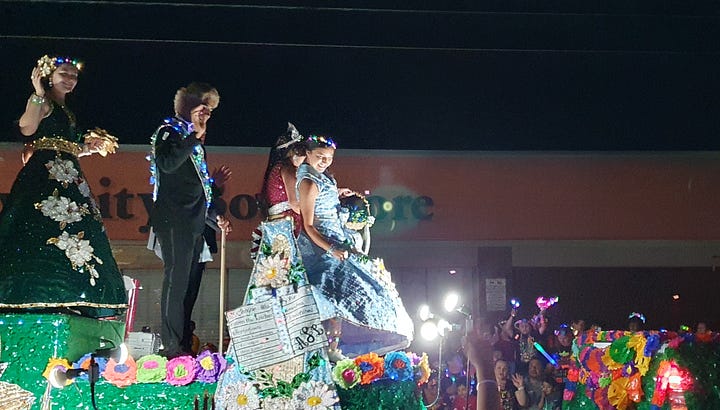
On their website, the "Battle of Flowers Association" also describe the mission they pursue: "..to proudly teach the history of our state and keep the patriotic traditions of Texas and San Antonio alive." This has earned the organization some criticism. Just as the entire Fiesta is repeatedly targeted. The deeply racist statements made by central figures in the historic Texan uprising against Mexico were ignored. And: why is the victory over Mexico celebrated with Mexican music, food and drink? The Fiesta, so the accusations are abbreviated, would celebrate "white supremacy" in its current form. The celebration should be decoupled from its warlike origins.
Over the years, two fiestas have crystallized, so to speak, writes the online medium Axios from San Antonio. Exclusive groups, such as the Order of the Alamo, where white people are predominantly among themselves, organize their celebrations at the Alamo - including the coronation of a queen, a princess and 24 duchesses. At the Witte Museum in San Antonio, visitors can marvel at a collection of magnificent coronation gowns that illustrate the changing styles and themes throughout history. Events such as the Flambeau Parade, the Oyster Bake, the Fiesta de Los Reyes, all of which are open to the public, would invite a casual multicultural get-together.
So I follow my friends' advice “Go to King William Parade!” and find myself the next morning in one of San Antonio's oldest neighborhoods, King William. The historic district is known and named for its Victorian-era houses and named in honor of Wilhelm I, King of Prussia, by one of the first German immigrants. The area became known as “Sauerkraut Bend” as many more German immigrants settled there and built the magnificent homes that still stand today. Carefully renovated.

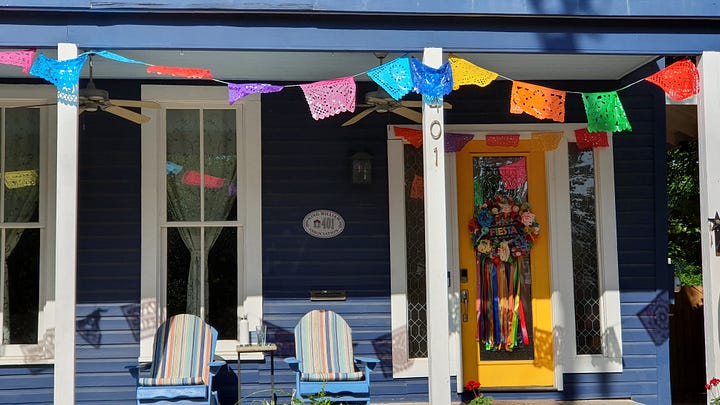
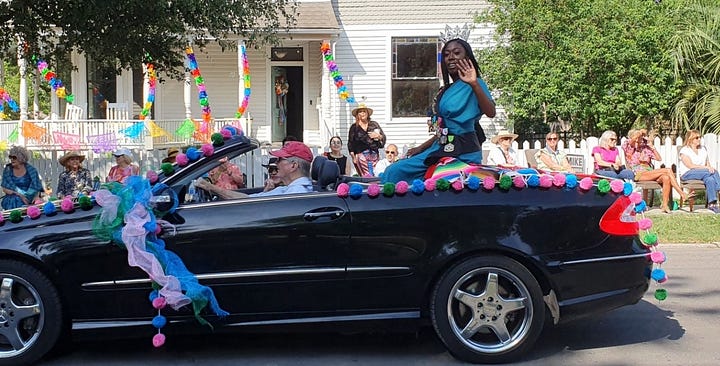

Right at the beginning, I meet an Asian-looking woman who has decked out her house and herself in sunny yellow, decorated with lots of colorful paper flowers. Members of the Battle of Flowers Association and their floats are also wrapped in their sunny yellow color. I see many Hispanic participants and spectators. Women from the Academy of Mexican Folk Dance show off traditional dresses and dance in the parade procession. Everyone seems to be having a good time, no one seems to feel discriminated against in the colorful hustle and bustle. A black queen (?), princess (?), duchess (?) with a glittering tiara in her hair sits in a cabriolet and waves to the onlookers sitting in camping chairs along the street. (Video ©Rebecca Hillauer)
Everything is more relaxed here than at the pompous “Battle of the Flowers” parade. Less spectacular. But in my opinion with more imaginative costumes. And the atmosphere is naturally more informal. People who know each other from somewhere, perhaps neighbors or work colleagues, greet and hug each other more often. No question: I feel much more comfortable at the King William parade. All thumbs up!



